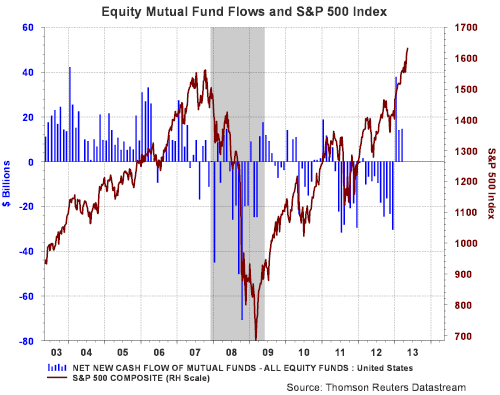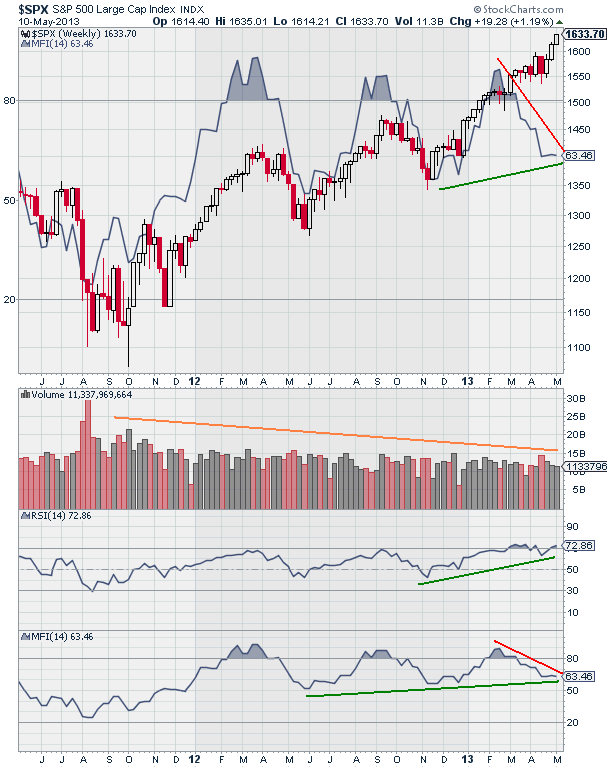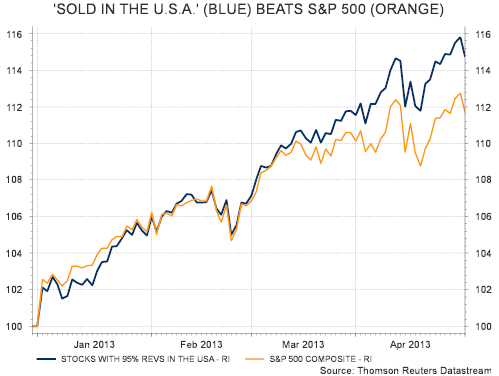 |
| From The Blog of HORAN Capital Advisors |
 |
| From The Blog of HORAN Capital Advisors |
 |
| From The Blog of HORAN Capital Advisors |
 |
| From The Blog of HORAN Capital Advisors |
Posted by
David Templeton, CFA
at
12:17 AM
0
comments
![]()
![]()
Labels: Bond Market , Investments
"...In the wake of difficult times such as the financial crisis that began in 2007, the concept of market efficiency is sometimes criticized. However, while no market is perfectly efficient, the evidence suggests that behaving as if markets were highly efficient provides investors with a solid approach (emphasis added)."
Posted by
David Templeton, CFA
at
5:53 PM
0
comments
![]()
![]()
"the earnings yield on the S&P 500 was 5.4% (based on trailing GAAP EPS through Q1 2013), and nearly three times as high as the 1.9% yield on the 10-year Treasury bond. The last time the EPS yield was this far above the 10-year note yield was in 1955....Common wisdom holds that if stocks are yielding a lot (in EPS) relative to bonds (in interest), stocks are more attractive than bonds."
 |
| From The Blog of HORAN Capital Advisors |
 |
| From The Blog of HORAN Capital Advisors |
"since stocks are yielding nearly three times in EPS what bonds are yielding in interest, history suggests that stocks may be the more attractively valued asset class. And since the cyclical sectors are trading at a higher premium to their normal EPS-to-bond yield multiple than the defensive sectors, the recent rotation into cyclical sectors at the expense of the defensive ones is a trade that appears to us to have some sustainability."
Posted by
David Templeton, CFA
at
5:54 PM
0
comments
![]()
![]()
Labels: General Market
 |
| From The Blog of HORAN Capital Advisors |
Posted by
David Templeton, CFA
at
11:44 AM
0
comments
![]()
![]()
Labels: Sentiment
 |
| From The Blog of HORAN Capital Advisors |
 |
| From The Blog of HORAN Capital Advisors |
Posted by
David Templeton, CFA
at
2:51 PM
0
comments
![]()
![]()
Labels: General Market
 |
| From The Blog of HORAN Capital Advisors |
 |
| From The Blog of HORAN Capital Advisors |
Posted by
David Templeton, CFA
at
11:20 AM
0
comments
![]()
![]()
Labels: General Market , Technicals
 |
| From The Blog of HORAN Capital Advisors |
"Last month, Central Bank Publications and Royal Bank of Scotland Group Plc conducted a survey of 60 central bankers. Nearly 25% of respondents said they own stock shares or plan to buy them. The Bank of Japan, featured heavily in the news recently and holder of the world's second-largest level of reserves, said it will more than double investments in stock exchange-traded funds by 2014. The Bank of Israel bought stocks for the first time last year, and the Swiss National Bank and Czech National Bank have upped their holdings to at least 10% of reserves.
Of the 60 banks surveyed, 14 said they'd already invested in stocks or would do so within five years. In fact, this is the first time ever the question about stocks has been in this annual survey.
Behind the heightened interest in stocks are growing central-bank reserves requiring increased diversification. In US dollar terms, the four largest central banks have expanded their balance sheets to more than $13 trillion, compared to only $3 trillion 10 years ago. Most central banks have had heavy and consistent reliance on fixed-income securities, but with yields low (and falling) in many countries, keeping all reserves in fixed income risks a declining value of reserves.
However, 70% of the central banks in the survey (including the US Federal Reserve) indicated that stocks remain "beyond the pale." A few central banks, including the Fed and the Bank of England, have no mandate to purchase stocks directly.
Jim O'Neill, chairman of Goldman Sachs Asset Management, weighed in: 'I don't think people should worry about (central banks owning stocks). Frankly, it makes a huge amount of sense in a world of floating exchange rates and such incredible opportunity, why should central banks keep so much money in very short-term, liquid things when they're not going to ever need it?'"
Posted by
David Templeton, CFA
at
10:11 PM
0
comments
![]()
![]()
Labels: Bond Market , General Market
 |
| From The Blog of HORAN Capital Advisors |
 |
| From The Blog of HORAN Capital Advisors |
"The Money Flow Index (MFI) is an oscillator that uses both price and volume to measure buying and selling pressure. Created by Gene Quong and Avrum Soudack, MFI is also known as volume-weighted RSI. MFI starts with the typical price for each period. Money flow is positive when the typical price rises (buying pressure) and negative when the typical price declines (selling pressure). A ratio of positive and negative money flow is then plugged into an RSI formula to create an oscillator that moves between zero and one hundred. As a momentum oscillator tied to volume, the Money Flow Index (MFI) is best suited to identify reversals and price extremes with a variety of signals."
"The Money Flow Index is a rather unique indicator that combines momentum and volume with an RSI formula. RSI momentum generally favors the bulls when the indicator is above 50 and the bears when below 50. Even though MFI is considered a volume-weighted RSI, using the centerline to determine a bullish or bearish bias does not work as well. Instead, MFI is better suited to identify potential reversals with overbought/oversold levels, bullish/bearish divergences and bullish/bearish failure swings (emphasis added). As with all indicators, MFI should not be used by itself. A pure momentum oscillator, such as RSI, or pattern analysis can be combined with MFI to increase signal robustness."
 |
| From The Blog of HORAN Capital Advisors |
 |
| From The Blog of HORAN Capital Advisors |
Posted by
David Templeton, CFA
at
2:35 PM
0
comments
![]()
![]()
Labels: General Market , Technicals
 |
| From The Blog of HORAN Capital Advisors |
 |
| From The Blog of HORAN Capital Advisors |
Posted by
David Templeton, CFA
at
8:48 AM
0
comments
![]()
![]()
Labels: General Market
 |
| From The Blog of HORAN Capital Advisors |
Posted by
David Templeton, CFA
at
8:08 PM
0
comments
![]()
![]()
Labels: General Market
 |
| From The Blog of HORAN Capital Advisors |
 |
| From The Blog of HORAN Capital Advisors |
"Since 1999, the S&P 500 EWI has been consistently overweighted materials, consumer discretionary and utilities, and underweighted energy, health care and telecommunication services relative to the S&P 500. However, for other sectors the situation has varied considerably over time. In fact, even for sectors for which the S&P 500 EWI has been consistently overweight or underweight, the difference in concentration between the two indices has altered significantly.
Throughout the history, the largest change in the relative sector weights of the two indices has been in the information technology (IT) sector, mainly due to the change in the sector weights of the S&P 500 itself. During the technology bubble in the late 1990s, the IT sector weight of the S&P 500 increased to 33% in March 2000 from 13% at the start of 1998. Correspondingly, the S&P 500 EWI went from being underweight in the sector by less than 3% to being underweight by more than 20% in the same period. This has a very important implication that explains the different performance of the S&P 500 EWI relative to the S&P 500..."
 |
| From The Blog of HORAN Capital Advisors |
 |
| From The Blog of HORAN Capital Advisors |
Posted by
David Templeton, CFA
at
1:42 PM
0
comments
![]()
![]()
Labels: General Market
Posted by
David Templeton, CFA
at
10:10 AM
0
comments
![]()
![]()
Labels: Dividend Analysis